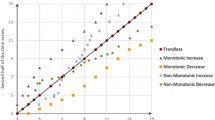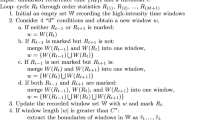Abstract
The Pettitt method, which is a rank-based test method, has been widely used to detect change point in the mean value of observed series. Traditionally the rank-based test has been assumed to be distribution-free and not sensitive to outliers and skewed distributions. However, there has no evidence provided to prove this assumption. Based on the work of Yue and Wang (Stoch Environ Res Risk Assess 16:307–323, 2002), this study defines the success rate of detecting the given change point as the ability of the Pettitt method, and investigates the ability in various circumstances by means of Monte Carlo simulation. Experiment results demonstrate that, the ability of the Pettitt method depends on not only the pre-assigned significance level, but also various properties of the sample data, including the sample size, the magnitude of a shift and the change point position. Besides, the distribution type and the distribution parameters such as the coefficient of variation, the coefficient of skewness and the shape parameter also seriously influence the ability. As expected, it is easier for the method to detect the change point when the sample size is larger, or the magnitude of a change point is bigger, or the variation of the sample data is smaller. And the highest ability is obtained when the change point occurs at the middle position of the series. These simulation results would provide users an extensive and detailed understanding about the use of the Pettitt method for the detection of change point.













Similar content being viewed by others
References
Adeloye AJ, Montaseri M (2002) Preliminary streamflow data analyses prior to water resources planning study. Hydrol Sci J 47(5):679–691
Antoch J, Huškova M, Janic MA, Ledwina T (2008) Data driven rank tests for the change point problem. Metrika 68:1–15
Bates BC, Chandler RE, Bowman AW (2012) Trend estimation and change point detection in individual climatic series using flexible regression methods. J Geophys Res 117:D16106. doi:10.1029/2011JD017077
Berkes I, Horvath L, Kokoszka P, Shao QM (2006) On discriminating between long-range dependence and changes in the mean. Ann Stat 34:1140–1165
Box GEP, Cox DR (1964) An analysis of transformation. J R Stat Soc B 26:211–252
Dehling H, Rooch A, Taqqu MS (2012) Non-parametric change point tests for long-range dependent data. Scand J Stat 40(1):153–173
Du J, Fang J, Xu W, Shi PJ (2012) Analysis of dry/wet conditions using the standardized precipitation index and its potential usefulness for drought/flood monitoring in Hunan Province, China. Stoch Environ Res Risk Assess. doi:10.1007/s00477-012-0589-6
Ferger D (1994) On the power of nonparametric change point tests. Metrika 41:277–292
Ferguson CR, Villarini G (2012) Detecting in-homogeneities in the twentieth century reanalysis over the central United States. J Geophys Res 117:D05123. doi:10.1029/2011JD016988
Giraitis L, Leipus R, Surgailis D (1996) The change point problem for dependent observations. J Stat Plan Inference 53:297–310
Hušková M, Kirch C (2012) Bootstrapping sequential change point tests for linear regression. Metrika 75(5):673–708
Kelly KS, Krzysztofowicz R (1997) A bivariate meta-Gaussian density for use in hydrology. Stoch Hydrol Hydraul 11:17–31
Kim M, Lee S (2011) Change point test for tail index for dependent data. Metrika 74(3):297–311
Ling S (2007) Testing for change points in time series models and limiting theorems for NED sequences. Ann Stat 35:1213–1227
Liu DD, Chen XH, Lian YQ, Lou ZH (2010) Impacts of climate change and human activities on surface runoff in the Dong jiang River basin of China. Hydrol Process 24:1487–1495
Liu L, Xu ZX, Huang JX (2012) Spatio-temporal variation and abrupt changes for major climate variables in the Tai hu Basin, China. Stoch Environ Res Risk Assess 26(6):777–791
Moran PAP (1969) Statistical inference with bivariate gamma distributions. Biometrika 56:627–634
Pettitt AN (1979) A non-parametric approach to the change point problem. Appl Stat 28(2):126–135
Rougé C, Ge Y, Cai X (2013) Detecting gradual and abrupt changes in hydrological records. Adv Water Resour 53:33–44
Spokoiny V (2009) Multiscale local change point detection with applications to value-at-risk. Ann Stat 37(3):1405–1436
Talwar PP, Gentle JE (1981) Detecting a scale shift in a random sequence at an unknown time point. Appl Stat 30(3):301–304
Tan C, Dong C, Miao B (2013) A self-normalization test for a change point in the shape parameter of a gamma distributed sequence. J Korean Stat Soc 42(3):359–369
Tarhule A, Woo MK (1998) Changes in rainfall characteristics in northern Nigeria. Int J Climatol 18:1261–1271
Varouchakis EA, Hristopulos DT, Karatzas GP (2012) Improving kriging of groundwater level data using nonlinear normalizing transformations-a field application. Hydrol Sci J 57(7):1404–1419
Villarini G, Serinaldi F, Smith JA, Krajewski WF (2009) On the stationarity of annual flood peaks in the continental United States during the 20th century. Water Resour Res 45:W08417. doi:10.1029/2008WR007645
Wang L (2008) Change-in-mean problem for long memory time series models with applications. J Stat Comput Simul 78:653–668
Wijngaard JB, Klein tank AMG, Konnen GP (2003) Homogeneity of 20th century European daily temperature and precipitation series. Int J Climatol 23:679–692
Wu C, Wu J, Luo Y, Zhang H, Teng Y, DeGloria SD (2011) Spatial interpolation of severely skewed data with several peak values by the approach integrating kriging and triangular irregular network interpolation. Environ Earth Sci 63(5):1093–1103
Xiong LH, Guo SL (2004) Trend test and change-point detection for the annual discharge series of the Yangtze River at the Yichang hydrological station. Hydrol Sci J 49(1):99–112
Yamaguchi K (2011) Estimating a change point in the long memory parameter. J Time Ser Anal 32(3):304–314
Yue S (2000) Joint probability distribution of annual maximum storm peaks and amounts as represented by daily rainfalls. Hydrol Sci J 45(2):315–326
Yue S, Wang CY (2002) Power of the Mann–Whitney test for detecting a shift in median or mean of hydro-meteorological data. Stoch Environ Res Risk Assess 16(4):307–323
Yue S, Pilon P, Cavadias G (2002) Power of the Mann–Kendall and Spearman’S rho tests for detecting monotonic trends in hydrological series. J Hydrol 259:254–271
Zhang Q, Liu CL, Xu CY, Xu YP, Jiang T (2006) Observed trends of annual maximum water level and streamflow during past 130 years in the Yangtze River basin, China. J Hydrol 324:255–265
Zhao W, Tian Z, Xia Z (2010) Ratio test for variance change point in linear process with long memory. Stat Pap 51(2):397–407
Acknowledgments
This research was supported by the National Natural Science Foundation of China (51190094 and 61271337). The authors are very grateful to the associate editor and two anonymous reviewers for their helpful suggestions and constructive comments.
Author information
Authors and Affiliations
Corresponding author
Rights and permissions
About this article
Cite this article
Xie, H., Li, D. & Xiong, L. Exploring the ability of the Pettitt method for detecting change point by Monte Carlo simulation. Stoch Environ Res Risk Assess 28, 1643–1655 (2014). https://doi.org/10.1007/s00477-013-0814-y
Published:
Issue Date:
DOI: https://doi.org/10.1007/s00477-013-0814-y




